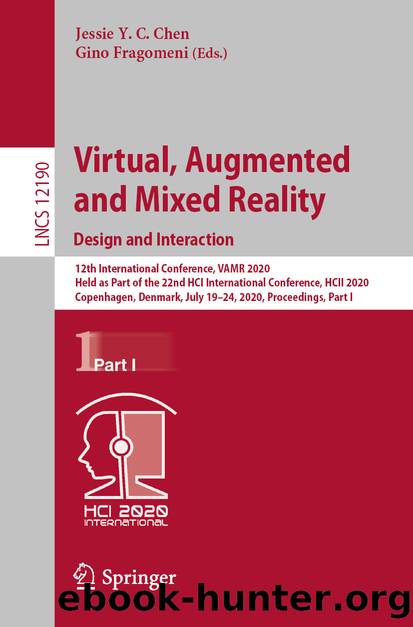Virtual, Augmented and Mixed Reality. Design and Interaction by Unknown

Author:Unknown
Language: eng
Format: epub
ISBN: 9783030496951
Publisher: Springer International Publishing
2.3 Cognitive Loading Considerations
An example of what is possible for a command and control system, and in particular methods to reduce cognitive loading, was discussed by Zollman et al. [15]. They investigated the application of micro aerial vehicles (MAVs) equipped with high-resolution cameras to create aerial reconstructions of selected locations. They identified that a challenge is that automatic flight path planning and autonomous flying is often applied but so far cannot fully replace the human in the loop for supervising the flight on-site to assure that there are no collisions with obstacles. They went on to discuss that this workflow yields several issues in cognitive loading, such as the need to mentally transfer the aerial vehicle’s position between 2D map positions and the physical environment, and the complicated depth perception of objects flying in the distance. They presented an AR supported navigation and flight planning of micro aerial vehicles by augmenting the user’s view with relevant information for flight planning and live feedback for flight supervision. Additionally, they introduced depth hints supporting the user in understanding the spatial relationship of virtual waypoints in the physical world and investigated the effect of these visualization techniques on the spatial understanding. So, the investigated highlighted the possibilities of an AR system and specific challenges related to cognitive processing.
Zollman et al. [15] highlighted a few of the cognitive loading issues related to the design of an AR based command and control system. There are several more that need to be considered [16, 17]. For example, Dodd et al. [18] investigated touch screen capability in aircraft cockpits and stated that as elements and workload increase in number and complexity, increased cognitive loading will follow. For the current effort this will drive the number and complexity of gestures we expect a participant to initiate for controlling the vehicle. As the research progresses beyond the flat screen additional factors come in to play. As AR capability is added, issues of switching views between the operator real-world view and a virtual framework need to be considered. Recent evidence indicates that very different brain processes are involved in comprehending meaning from these sources [19].
The above discussion highlights some of the complexities that can quickly emerge in a command and control system. So careful consideration must be given to the design of the simulation and real-life demonstration. The approach taken in this investigation is to minimize the load on the working memory. This will result in limiting the information transmitted to the user to include basic vehicle status (i.e., speed, altitude) and visual information to improve perception and vehicle component control. Taking this approach will keep the focus on the control aspect and suitability of the basic simulation environment.
Download
This site does not store any files on its server. We only index and link to content provided by other sites. Please contact the content providers to delete copyright contents if any and email us, we'll remove relevant links or contents immediately.
Algorithms of the Intelligent Web by Haralambos Marmanis;Dmitry Babenko(8518)
Test-Driven Development with Java by Alan Mellor(7348)
Data Augmentation with Python by Duc Haba(7249)
Principles of Data Fabric by Sonia Mezzetta(6994)
Learn Blender Simulations the Right Way by Stephen Pearson(6928)
Microservices with Spring Boot 3 and Spring Cloud by Magnus Larsson(6761)
RPA Solution Architect's Handbook by Sachin Sahgal(6166)
Hadoop in Practice by Alex Holmes(6028)
Jquery UI in Action : Master the concepts Of Jquery UI: A Step By Step Approach by ANMOL GOYAL(5869)
The Infinite Retina by Robert Scoble Irena Cronin(5868)
Big Data Analysis with Python by Ivan Marin(5692)
Life 3.0: Being Human in the Age of Artificial Intelligence by Tegmark Max(5397)
Pretrain Vision and Large Language Models in Python by Emily Webber(4652)
Infrastructure as Code for Beginners by Russ McKendrick(4435)
WordPress Plugin Development Cookbook by Yannick Lefebvre(4166)
Functional Programming in JavaScript by Mantyla Dan(4121)
The Age of Surveillance Capitalism by Shoshana Zuboff(4111)
Embracing Microservices Design by Ovais Mehboob Ahmed Khan Nabil Siddiqui and Timothy Oleson(3956)
Applied Machine Learning for Healthcare and Life Sciences Using AWS by Ujjwal Ratan(3929)
